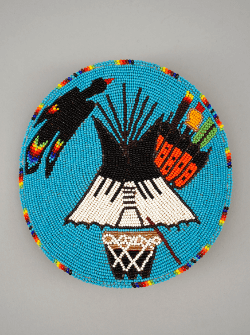For the past two years, the Gilcrease Museum digital collections and anthropology departments have been cataloging and imaging 1,500 American Indian ethnographic items. This work is a result of the museum’s second consecutive Institute of Museum and Library Services (IMLS)* grant.
Awarded in December 2017, the project is more than halfway complete.
“The IMLS has given us the opportunity to use a high-quality camera and work closely with complex items, such as outfits of clothing and kits used by roadmen of the Native American Church,” said Diana Folsom, director of digital collections. “Since these require lengthy set-ups and content knowledge, The University of Tulsa anthropology graduate students have been key to our success. Soon, online visitors will be able to closely study materials and techniques.”
With a focus on ethnographic items related to the cultures and lives of the indigenous peoples living in Northeast Oklahoma, emphasizing the Osage, Cherokee and Muscogee (Creek) Nations, the work will encourage educational opportunities through increased access online and later through open-storage experiences in the Kravis Discovery Center.
“Creating a digital experience allows us to share more of the collection, enlarge our audience worldwide and invite interaction with experts, which adds to our base of knowledge and encourages cultural connections,” Folsom explained.
The items selected for this project, dating from the late 19th to early 20th centuries, represent the cultures and history of Oklahoma-based tribes to which many current Oklahoma residents trace all or part of their ancestry. Regalia, cradle boards, bandolier bags, drums and baskets are but a few examples of the types of objects being digitized.
While digitization is a monumental task in its own right, the museum is taking this grant to the next level with the help of Dr. Garrick Bailey, professor of anthropology at TU. With an extensive background in and knowledge of American Indian art and material culture, he has served as an extension of the team by providing commentary on objects in coordination with their digitization. Chronicling each priceless story, the narratives will add another layer of accessible information to specific objects.
“I am able to apply a lifetime of knowledge to help expand understanding of the rich and important Gilcrease ethnographic collection,” Bailey said.
With the work seemingly never ending, the funding from this IMLS grant has enabled staff to make monumental strides in the effort to learn more about our collection of 400,000+ items.
